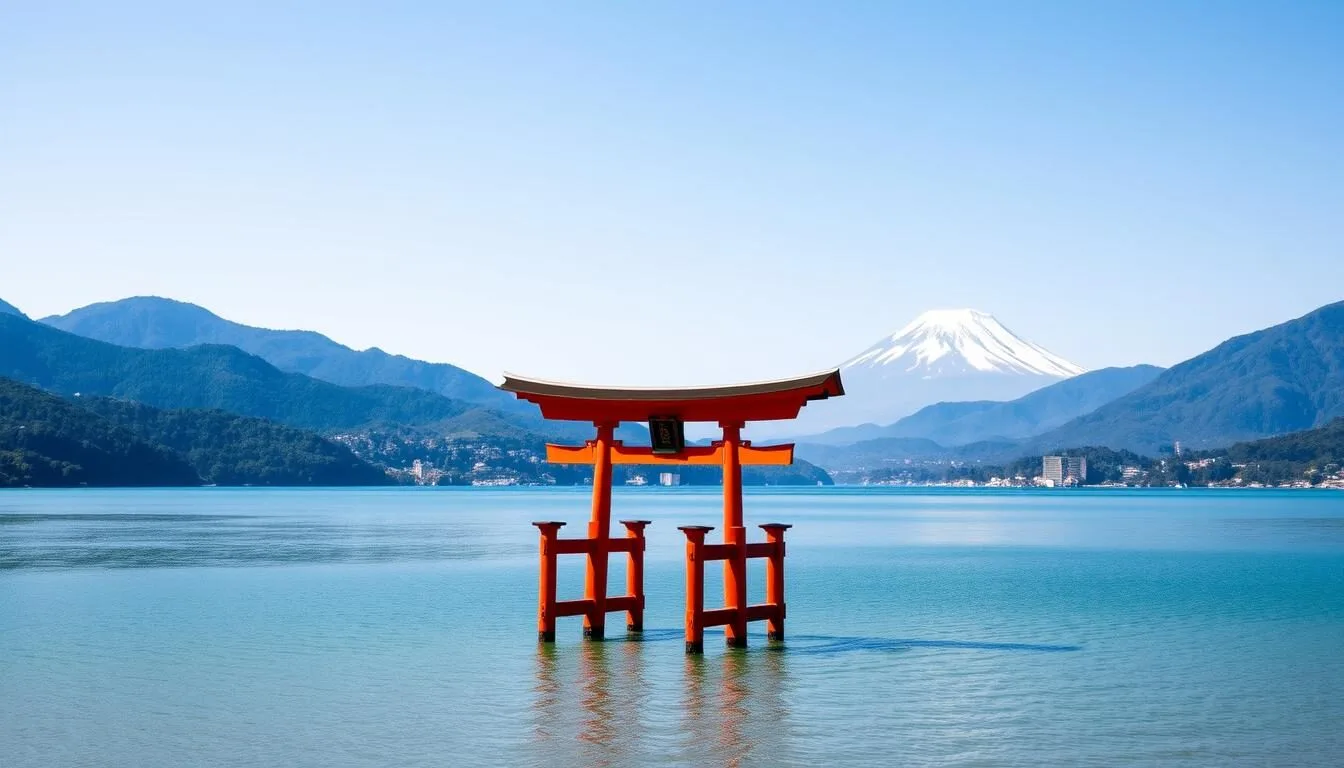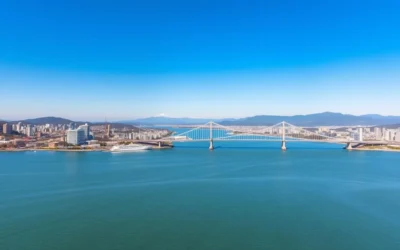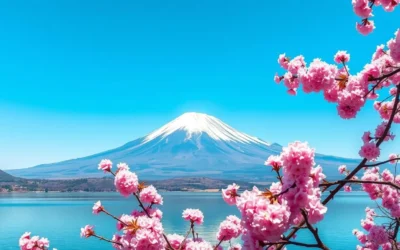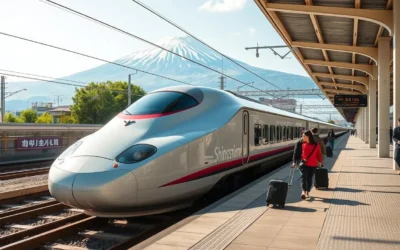Did you know that Hakone is home to over 20 natural hot springs that produce an astonishing 11.5 million liters of therapeutic water daily? This volcanic wonderland, just 90 minutes from Tokyo, has been a healing retreat for Japanese locals for over 1,200 years. Today, we’ll explore the best things to do in this geothermal paradise where ancient traditions meet breathtaking natural beauty.
Planning Your Trip to Hakone
Hakone sits within the Fuji-Hakone-Izu National Park in Kanagawa Prefecture, making it an ideal destination for those seeking natural beauty, cultural experiences, and relaxation. Before diving into specific attractions, let’s cover some essential planning information to help you make the most of your visit.
Getting to Hakone
The most convenient way to reach Hakone from Tokyo is via the Odakyu Line from Shinjuku Station. The Limited Express Romancecar offers a comfortable 85-minute journey with panoramic views (reserved seats required). Alternatively, you can take the regular Odakyu Line train and transfer at Odawara Station to the Hakone Tozan Railway.
If you’re coming from other parts of Japan, you can take the Shinkansen to Odawara Station and then transfer to local transportation. For international travelers, the nearest airports are Haneda and Narita in Tokyo.
Ready to book your flight to Japan?
Find the best deals on international flights to Tokyo to start your Hakone adventure.
Best Time to Visit
Hakone is beautiful year-round, but each season offers a unique experience:
- Spring (March-May): Cherry blossoms and azaleas bloom, creating picturesque landscapes. Temperatures are mild and comfortable for sightseeing.
- Summer (June-August): While humidity is high, the mountains provide a cooler escape from Tokyo’s heat. Summer festivals add cultural experiences.
- Autumn (September-November): The fall foliage transforms Hakone into a canvas of red, orange, and gold. This is considered by many to be the most beautiful season.
- Winter (December-February): Cold temperatures make the hot springs especially appealing. On clear winter days, Mount Fuji views are at their most spectacular.
The Hakone Freepass
For the most cost-effective way to explore Hakone, consider purchasing the Hakone Freepass. This tourist pass includes unlimited use of trains, buses, cable cars, ropeways, and the sightseeing cruise on Lake Ashi. Available in 2-day and 3-day versions, it can save you significant money if you plan to use multiple forms of transportation. You can purchase it at Shinjuku Station or Odawara Station before heading to Hakone.

Getting Around Hakone
Hakone’s transportation network is an attraction in itself, offering unique ways to traverse the mountainous terrain while enjoying spectacular views.
Hakone Tozan Railway
Japan’s oldest mountain railway winds its way up the mountains through switchbacks and tunnels. The journey from Hakone-Yumoto to Gora takes about 40 minutes and offers beautiful views, especially during hydrangea season (June) and autumn foliage (November).
Hakone Ropeway
This aerial tramway connects Sounzan to Togendai, passing over Owakudani’s volcanic valley. The 30-minute journey provides breathtaking views of Mount Fuji on clear days and a unique perspective of the sulfuric vents below.
Hakone Sightseeing Cruise
Replicas of European pirate ships cruise across Lake Ashi, offering yet another vantage point for Mount Fuji views. The cruise connects Togendai, Hakone-machi, and Moto-Hakone ports.
Buses connect major attractions and areas not covered by the other transportation methods. With the Hakone Freepass, you can hop on and off these various modes of transport to create your own sightseeing route.
Explore Hakone at your own pace
Rent a car to discover hidden gems and travel on your own schedule.
Top Things to Do in Hakone
1. Soak in Hakone’s Famous Onsen (Hot Springs)
Hakone’s volcanic activity creates mineral-rich hot springs that have attracted visitors for centuries. Experiencing an onsen is a must-do activity that offers both relaxation and a glimpse into Japanese bathing culture.

Many ryokans (traditional Japanese inns) offer private and public baths, but there are also day-use facilities for visitors not staying overnight. Popular options include:
- Tenzan Onsen: A tattoo-friendly facility with multiple outdoor baths set in a beautiful garden environment.
- Hakone Yuryo: Features both indoor and outdoor baths with a free shuttle from Hakone-Yumoto Station.
- Yunessun: A unique “onsen theme park” with both traditional baths and family-friendly swimsuit areas featuring unusual baths like wine, coffee, and green tea.
Onsen Etiquette: Traditional onsens require bathing nude and are typically gender-separated. Wash thoroughly before entering the bath, keep your small towel out of the water, and never bring food or drinks to the bathing area. Some facilities prohibit visitors with tattoos due to historical associations with yakuza (Japanese organized crime), but attitudes are changing, and more tattoo-friendly options are becoming available.
2. Visit the Iconic Hakone Shrine
The Hakone Shrine (also known as Kuzuryu Shrine) is one of the most photographed spots in the region. This Shinto shrine dedicated to the nine-headed dragon deity has a history dating back over 1,000 years.
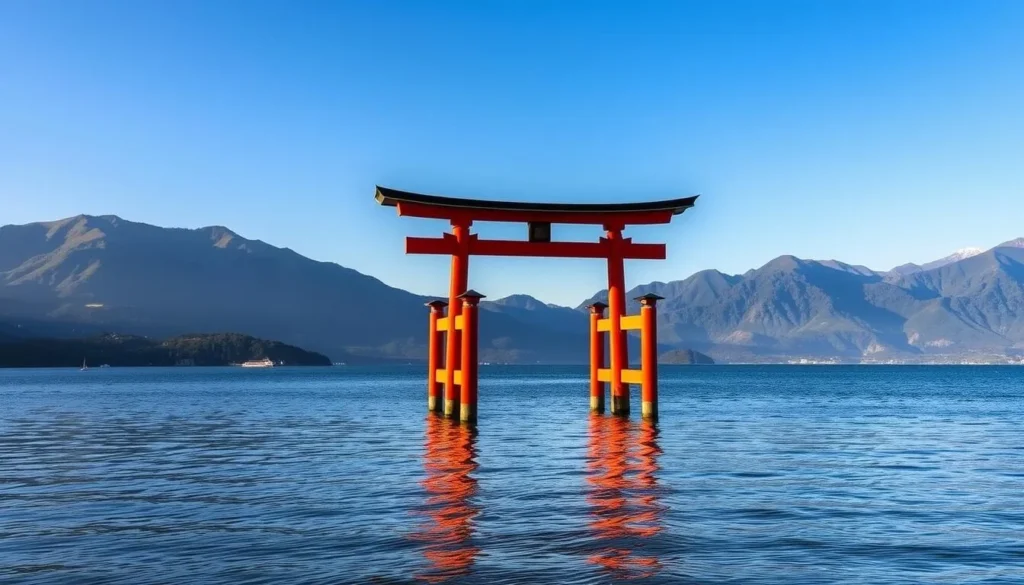
The most famous part is the “Heiwa no Torii” (Peace Gate), a vermilion torii gate that appears to float on Lake Ashi. To reach the main shrine buildings, follow the path lined with lanterns through a forest of massive cedar trees. The peaceful atmosphere and beautiful architecture make this a must-visit spiritual site.
For the best experience, visit early in the morning to avoid crowds, especially at the lakeside torii gate which is a popular photo spot. The shrine is open 24 hours and has no admission fee.
3. Explore the Hakone Open-Air Museum
Art lovers shouldn’t miss the Hakone Open-Air Museum (Hakone Chokoku no Mori Bijutsukan), which harmoniously blends art and nature across its sprawling grounds.
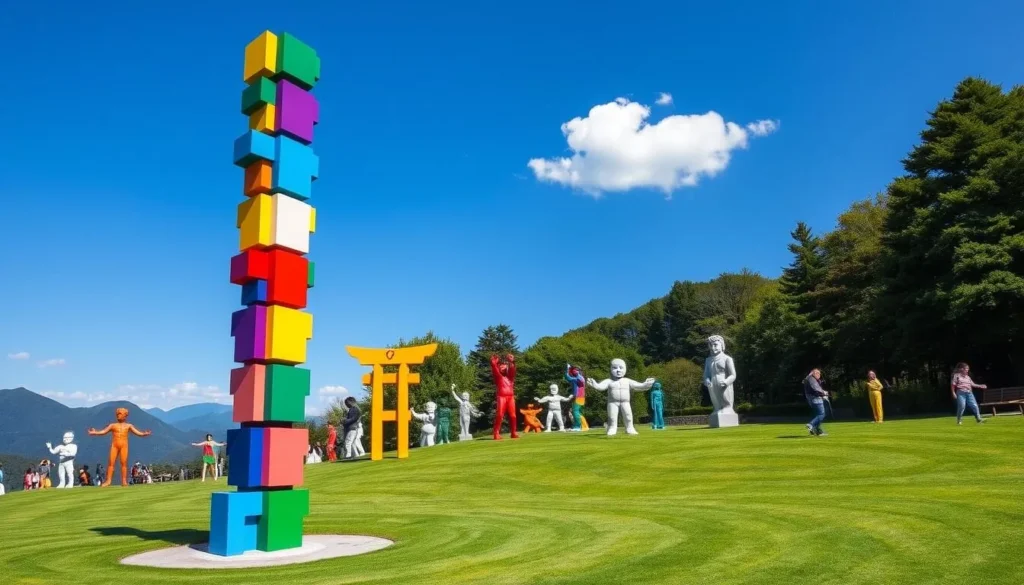
Opened in 1969 as Japan’s first outdoor art museum, this unique attraction features over 120 sculptures by renowned artists including Rodin, Moore, and Miró. The sculptures are displayed across the 70,000 square meter park against the backdrop of Hakone’s beautiful mountains.
Don’t miss the Picasso Pavilion, which houses a collection of the artist’s works, and the foot bath where you can rest your feet in natural hot spring water while admiring the scenery. Interactive installations like the “Woods of Net” and the “Curved Space Diamond” are particularly popular with children.
Experience Hakone’s Art and Culture
Book a guided tour to learn about the history and significance of Hakone’s cultural treasures.
Browse Guided Tours
4. Ride the Hakone Ropeway Over Owakudani
The Hakone Ropeway provides not just transportation but an unforgettable experience as it carries you over Owakudani, an active volcanic valley with sulfur vents and hot springs.

The 30-minute journey from Sounzan to Togendai offers spectacular views of Mount Fuji on clear days. The most dramatic section passes directly over Owakudani’s bubbling sulfur pits, where you can witness the earth’s geothermal activity up close.
At Owakudani Station, you can disembark to explore the volcanic valley on foot via designated walking paths. Here, you can try the famous “kuro-tamago” (black eggs) – regular eggs boiled in the sulfuric hot springs, which turn the shells black. According to local legend, eating one egg adds seven years to your life!
Note: Owakudani occasionally closes due to increased volcanic activity. Check current conditions before planning your visit. The ropeway may also suspend operations during strong winds or poor visibility.
5. Cruise Lake Ashi on a Pirate Ship
One of Hakone’s most unique experiences is cruising across Lake Ashi (Ashinoko) on a replica pirate ship. These whimsical vessels offer a fun way to travel between key sightseeing areas while enjoying magnificent views.

The cruise connects three ports: Togendai, Hakone-machi, and Moto-Hakone. A one-way journey takes approximately 30 minutes. From the deck, you’ll enjoy panoramic views of the surrounding mountains and, on clear days, Mount Fuji rising majestically in the distance.
The ships operate year-round, with each season offering a different perspective on the landscape – from cherry blossoms in spring to snow-capped mountains in winter. The cruise is included in the Hakone Freepass, making it an easy addition to your itinerary.
6. Walk the Old Tokaido Highway
Step back in time by walking a preserved section of the historic Tokaido Highway, which once connected Tokyo (Edo) and Kyoto during the feudal era.
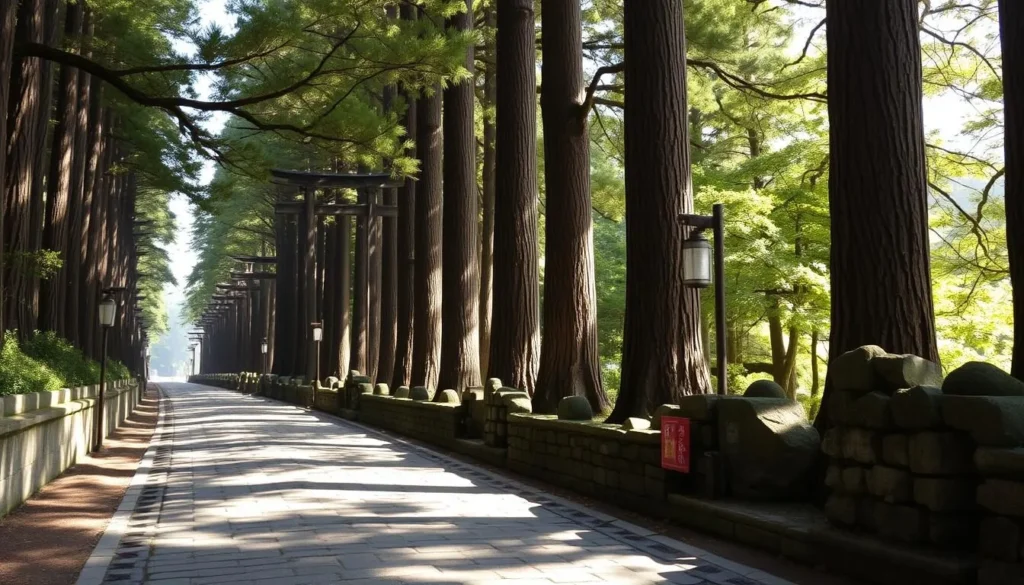
The best-preserved section runs from Moto-Hakone to Hakone-Yumoto, with the most popular stretch being the Cedar Avenue (Sugi-namiki) between Moto-Hakone and Hatajuku. This atmospheric path is lined with towering 400-year-old cedar trees that were planted during the Edo period to provide shade for travelers.
Along the route, you’ll find the restored Hakone Checkpoint (Hakone Sekisho), where officials once controlled the movement of people and goods, particularly weapons and women entering or leaving Edo. The checkpoint museum offers insights into the security measures of feudal Japan.
Don’t miss the opportunity to stop at the historic Amazake-chaya teahouse, which has been serving travelers for over 400 years. This traditional establishment offers amazake (sweet, non-alcoholic rice drink) and Japanese sweets – the perfect refreshment during your historical walk.
Discover Hakone’s History with a Guide
Book a guided hiking tour of the Old Tokaido Highway to learn about its fascinating history from local experts.
Book a Guided Hike
7. Visit Hakone’s Unique Museums
Beyond the Open-Air Museum, Hakone boasts several specialized museums worth exploring:
Hakone Venetian Glass Museum
This museum showcases exquisite Venetian glasswork in a European-style building surrounded by beautiful gardens. The outdoor crystal forest with glass sculptures is particularly magical, especially when illuminated at night.
Pola Museum of Art
Built harmoniously into the forest landscape, this modern museum houses an impressive collection of European paintings (including works by Monet, Renoir, and Picasso) alongside Japanese paintings and ceramics.
Hakone Museum of Photography
Dedicated to showcasing beautiful photographs of Mount Fuji through different seasons and perspectives, this small museum offers a unique appreciation of Japan’s iconic mountain.

8. Hike Mount Kintoki
For outdoor enthusiasts, hiking Mount Kintoki (1,212m) offers one of the best views of Mount Fuji in the Hakone region.
The trail begins at Kintoki Shrine and takes approximately 90 minutes to reach the summit. Though challenging with some steep sections, the hike rewards you with panoramic views of Hakone, Lake Ashi, and on clear days, a perfect view of Mount Fuji.
At the summit, you’ll find a small teahouse where you can enjoy a cup of amazake (sweet rice drink) while taking in the magnificent scenery. The hike is particularly beautiful during autumn when the surrounding forests display vibrant fall colors.
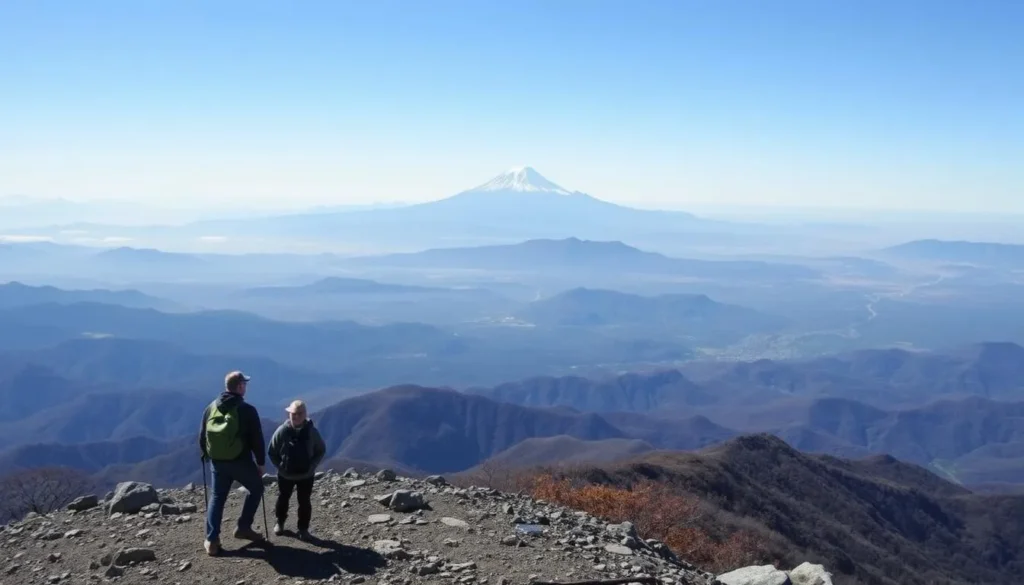
Hiking Tips: Wear proper hiking shoes, bring plenty of water, and start early to ensure you have enough time to return before sunset. Check weather conditions before setting out, as fog can obscure the views and make trails slippery.
Where to Stay in Hakone
Hakone offers a range of accommodation options, from luxury ryokans to budget-friendly hotels and guesthouses. Where you stay can significantly enhance your Hakone experience.
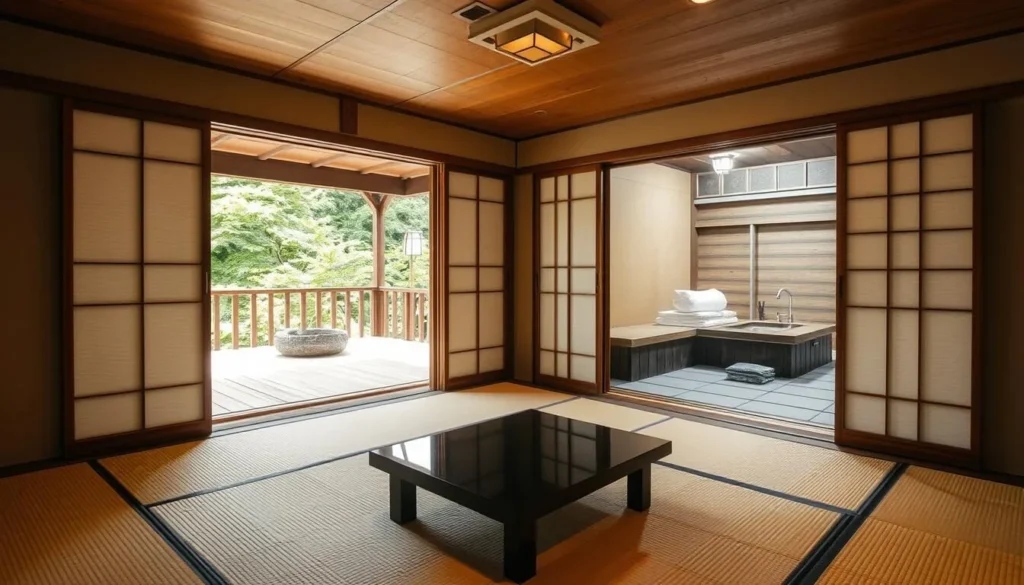
Traditional Ryokans
For an authentic Japanese experience, stay at a ryokan (traditional inn). These accommodations typically offer tatami-mat rooms, kaiseki (multi-course) meals, and access to private or public onsen baths. Many ryokans in Hakone have their own hot spring sources.
Popular areas: Yumoto, Miyanoshita, and Gora
Price range: ¥20,000-¥50,000 per person per night (including dinner and breakfast)
Modern Hotels
If you prefer Western-style accommodations, Hakone has several modern hotels with comfortable amenities. Many still offer onsen facilities while providing familiar comforts like beds instead of futons.
Popular areas: Lake Ashi shoreline, Gora
Price range: ¥15,000-¥30,000 per room per night
Budget Options
Travelers on a budget can find guesthouses, hostels, and minshuku (family-run B&Bs) throughout Hakone. Many offer shared onsen facilities and comfortable accommodations at reasonable prices.
Popular areas: Hakone-Yumoto
Price range: ¥5,000-¥12,000 per person per night
Best Areas to Stay
Hakone-Yumoto
As the gateway to Hakone, this area offers convenient access to transportation and has the highest concentration of shops and restaurants. It’s ideal for first-time visitors and those who want to be close to amenities.
Gora
Located in the heart of Hakone, Gora provides easy access to the ropeway and cable car. The area is home to several museums and gardens, making it perfect for culture enthusiasts.
Lake Ashi Area
Staying near Lake Ashi (in Moto-Hakone or Hakone-machi) offers stunning views and proximity to the Hakone Shrine. This area is more peaceful but has fewer dining options.
Sengokuhara
Known for its beautiful pampas grass fields in autumn, this quieter area is perfect for nature lovers seeking a peaceful retreat away from the main tourist routes.
Hakone’s Local Cuisine
While exploring Hakone, be sure to sample these local specialties:

Kuro-Tamago (Black Eggs)
These famous eggs are regular chicken eggs boiled in Owakudani’s hot springs. The sulfur in the water turns the shells black while the inside remains normal. According to local folklore, eating one adds seven years to your life!
Yuba (Tofu Skin)
This delicacy is made from the skin that forms on the surface of boiled soy milk. In Hakone, it’s served in various ways – fresh, dried, in soups, or wrapped around other ingredients. Try the yuba-don (tofu skin over rice) at specialized restaurants in Hakone-Yumoto.
Onsen Manju
These steamed buns filled with sweet bean paste are a traditional snack in hot spring towns. In Hakone, they’re often steamed using the natural hot spring steam, giving them a unique flavor.
Where to Eat
- Amazake-Chaya: This 400-year-old teahouse along the Old Tokaido Highway serves traditional amazake (sweet rice drink) and freshly grilled mochi (rice cakes).
- Yubadon Naokichi: Located in Hakone-Yumoto, this restaurant specializes in yuba dishes made with pure Hakone mountain water.
- Gora Brewery & Grill: For a modern dining experience, this craft brewery offers excellent food paired with locally brewed beers.
- Ryokan Dining: If staying at a ryokan, don’t miss the kaiseki dinner – a multi-course traditional meal featuring seasonal ingredients and artistic presentation.
Experience Hakone’s Culinary Delights
Book a food tour to discover the best local specialties with expert guidance.
Explore Food Tours
Practical Tips for Visiting Hakone
Weather and What to Pack
Hakone’s mountain climate means temperatures can be 5-10°C cooler than Tokyo. Summers are warm and humid, while winters can be quite cold, especially at higher elevations.
- Spring/Fall: Layers, light jacket, comfortable walking shoes, umbrella
- Summer: Light clothing, rain gear (June-July is rainy season), hat, sunscreen
- Winter: Warm coat, gloves, scarf, waterproof footwear
- Year-round: Small towel for onsen visits, swimwear (for some mixed onsen facilities)
Language and Communication
While English signage is available at major tourist sites, having a few basic Japanese phrases can enhance your experience. Consider downloading a translation app like Google Translate, which can help with menus and conversations.
Free Wi-Fi is available at many hotels, restaurants, and tourist information centers. For constant connectivity, consider renting a pocket Wi-Fi device or purchasing a Japanese SIM card upon arrival in Japan.
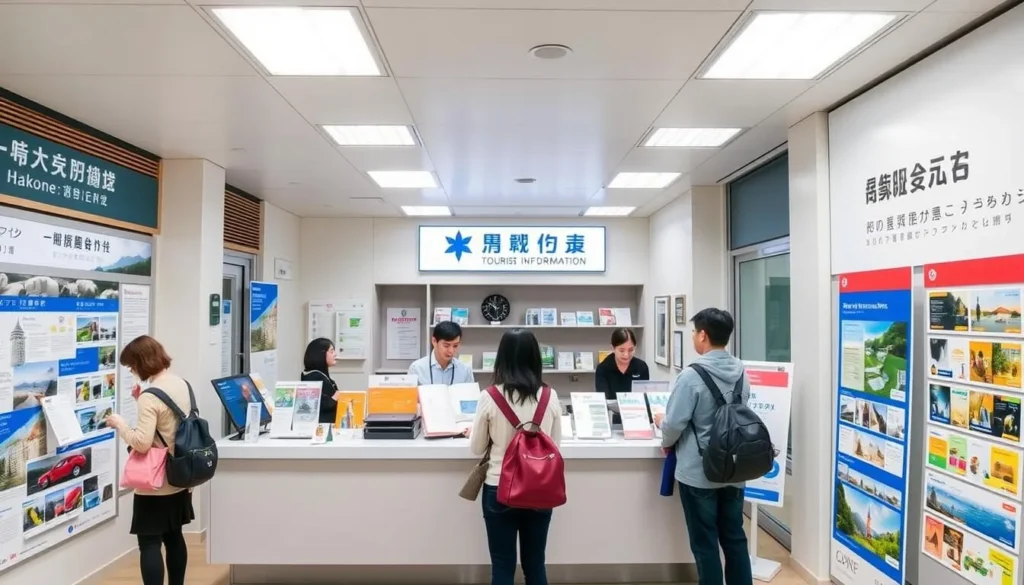
Money Matters
Japan remains largely a cash-based society, especially in rural areas like Hakone. While major hotels and some restaurants accept credit cards, it’s advisable to carry sufficient cash. ATMs that accept international cards can be found at 7-Eleven convenience stores and post offices.
The Hakone Tourist Information Center in Hakone-Yumoto Station provides currency exchange services, maps, and assistance in multiple languages.
How many days should I spend in Hakone?
While Hakone can be visited as a day trip from Tokyo, staying at least one night allows you to experience the onsen culture and explore at a more relaxed pace. A 2-3 day stay is ideal to cover the major attractions without rushing.
When is the best time to see Mount Fuji from Hakone?
Winter months (December-February) typically offer the clearest views of Mount Fuji due to lower humidity and fewer cloudy days. Early mornings are generally better than afternoons. However, the mountain is notoriously shy, and visibility depends on weather conditions regardless of season.
Are tattoos allowed in Hakone’s onsens?
Traditionally, many Japanese onsens prohibit tattoos due to their association with yakuza (organized crime). However, attitudes are changing, and some facilities in Hakone are becoming more tattoo-friendly, especially those catering to international tourists. Tenzan Onsen and some private onsen ryokans explicitly allow tattoos. If in doubt, check with your accommodation or consider booking a private onsen bath.
Sample Itineraries for Hakone
One-Day Itinerary
- Start at Hakone-Yumoto Station and take the Hakone Tozan Railway to Gora
- Visit the Hakone Open-Air Museum
- Take the cable car to Sounzan, then the ropeway to Owakudani
- Explore Owakudani and try the black eggs
- Continue on the ropeway to Togendai
- Board the sightseeing cruise across Lake Ashi
- Visit Hakone Shrine at Moto-Hakone
- Return to Hakone-Yumoto by bus
Two-Day Itinerary
Day 1:
- Follow the one-day itinerary above
- Check into a ryokan and enjoy a traditional dinner
- Relax in the onsen baths in the evening
Day 2:
- Start with an early morning onsen bath
- Visit the Hakone Venetian Glass Museum or Pola Museum of Art
- Walk a section of the Old Tokaido Highway
- Stop at Amazake-Chaya for a traditional snack
- Visit the Hakone Checkpoint
- Return to Hakone-Yumoto for souvenir shopping before departure

Ready to experience Hakone?
Find the perfect accommodation for your Hakone adventure.
Experience the Magic of Hakone
Hakone offers a perfect blend of natural beauty, cultural experiences, and relaxation that makes it one of Japan’s most beloved destinations. From soaking in mineral-rich hot springs while gazing at Mount Fuji to exploring ancient highways once walked by samurai, Hakone rewards visitors with unforgettable experiences at every turn.
Whether you’re seeking a peaceful retreat from Tokyo’s urban energy or an adventure through volcanic landscapes, Hakone’s diverse attractions cater to all interests. The region’s unique transportation network turns getting around into part of the experience itself, while the warm hospitality of traditional ryokans provides insight into authentic Japanese culture.
As you plan your journey to Japan, make sure to carve out time for Hakone – a magical destination where ancient traditions and natural wonders create memories that will last a lifetime.
—
The above is subject to change.
Check back often to TRAVEL.COM for the latest travel tips and deals.
